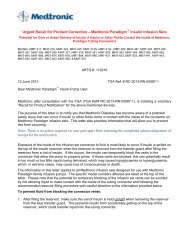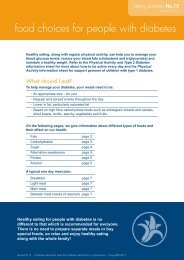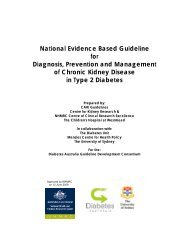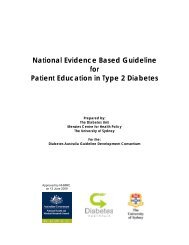Part 6: Detection and Prevention of Foot Problems in Type 2 Diabetes
Part 6: Detection and Prevention of Foot Problems in Type 2 Diabetes
Part 6: Detection and Prevention of Foot Problems in Type 2 Diabetes
You also want an ePaper? Increase the reach of your titles
YUMPU automatically turns print PDFs into web optimized ePapers that Google loves.
Evidence Table: Section 9AuthorGlycaemic control <strong>and</strong> peripheral neuropathyLevel <strong>of</strong> EvidenceLevel Study <strong>Type</strong>EvidenceQualityRat<strong>in</strong>gMagnitudeRat<strong>in</strong>gRelevanceRat<strong>in</strong>gAzad N (1999)(Adults – US)II RCT High Medium + HighDyck PJ (1999)(Adults – US)III-2 Cohort High High + HighGaster B (1998) I Systematic Review High High + HighHotta N (1993)(Adults – Japan)II RCT Medium High + LowKle<strong>in</strong> R (1995)(Adults – US)III-2 Cohort High High + HighKle<strong>in</strong> R (1996)(Adults – US)III-2 Cohort High High + HighOhkubo Y (1995)(Adults – Japan)II RCT Medium High + LowTovi J (1998)(Adults – Sweden)II RCT Medium Low HighUKPDS 33 (1998)(Adults – UK)II RCT High High + Highvan de Poll-Franse LV(2002)III-2 Cohort High High + High(Adults – The Netherl<strong>and</strong>s)For magnitude rat<strong>in</strong>g:+<strong>in</strong>dicates positive effect <strong>of</strong> glycaemic control on diabetic foot disease . High = cl<strong>in</strong>ically important & statistically significant;Medium = small cl<strong>in</strong>ical importance & statistically significant; Low = no statistically significant effect.Criteria for Quality <strong>and</strong> Relevance rat<strong>in</strong>gs are detailed <strong>in</strong> Appendix 9.72
















